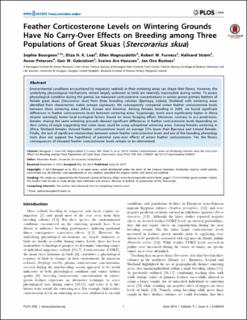Feather Corticosterone Levels on Wintering GroundsHave No Carry-Over Effects on Breeding among ThreePopulations of Great Skuas (Stercorarius skua)
Bourgeon, Sophie; Leat, Eliza H. K.; Magnusdottir, Ellen; Furness, Robert W.; Strøm, Hallvard; Petersen, Aevar; Gabrielsen, Geir W.; Hanssen, Sveinn Are; Bustnes, Jan Ove
Peer reviewed, Journal article

Åpne
Permanent lenke
https://hdl.handle.net/11250/3057563Utgivelsesdato
2014Metadata
Vis full innførselSamlinger
- Publikasjoner fra CRIStin - NINA [2364]
- Scientific publications [1392]
Sammendrag
Environmental conditions encountered by migratory seabirds in their wintering areas can shape their fitness. However, the
underlying physiological mechanisms remain largely unknown as birds are relatively inaccessible during winter. To assess
physiological condition during this period, we measured corticosterone concentrations in winter-grown primary feathers of
female great skuas (Stercorarius skua) from three breeding colonies (Bjørnøya, Iceland, Shetland) with wintering areas
identified from characteristic stable isotope signatures. We subsequently compared winter feather corticosterone levels
between three wintering areas (Africa, Europe and America). Among females breeding in 2009, we found significant
differences in feather corticosterone levels between wintering areas. Surprisingly, levels were significantly higher in Africa
despite seemingly better local ecological factors (based on lower foraging effort). Moreover, contrary to our predictions,
females sharing the same wintering grounds showed significant differences in feather corticosterone levels depending on
their colony of origin suggesting that some skuas could be using suboptimal wintering areas. Among females wintering in
Africa, Shetland females showed feather corticosterone levels on average 22% lower than Bjørnøya and Iceland females.
Finally, the lack of significant relationships between winter feather corticosterone levels and any of the breeding phenology
traits does not support the hypothesis of potential carry-over effects of winter feather corticosterone. Yet, the fitness
consequences of elevated feather corticosterone levels remain to be determined.
